Carbon Offsets for Business: A Definitive Guide (+ Top 5 Verified Programs)
Have you begun to carbon offset your business? If not, now is the perfect moment to join the carbon offset frenzy and pull your weight in achieving the net zero!
Carbon offsets for business offer an alternative way for organizations to reduce their gross emissions while also sponsoring projects that help with developing better, sustainable solutions.
As a result, the need for more carbon offset programs is skyrocketing… Not just in Northern America, but also the world over!
But before you join in, this in-depth guide will teach you about the different types of offset programs, the verified vs. shady providers, plus the benefits AND risks involved.
I also covered most important criteria you can use when figuring out whether they’ll use your dollar the way they claim they will.
But first, let’s see what types of programs are there to begin with.
6 Types of Carbon Offset Programs
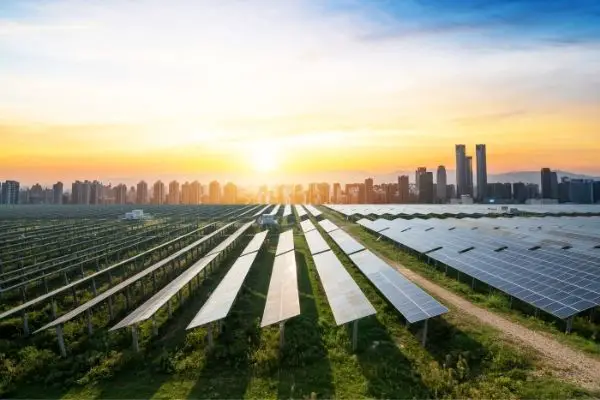
Which type of offset should you pick for your business? It depends on what you want to achieve.
The bottom line, though, is that all or most of them seek to reduce or prevent a specific amount of CO2 from spewing into our atmosphere.
These projects are also assessed by third-party bodies (more on them below) that verify whether their offsets meet the set criteria.
But enough of that!
CORE (Carbon Offset Research and Education) identifies 6 major types of offset projects:
- Energy Efficiency – This may include distributing more energy-efficient cooking stoves or energy-efficient lighting bulbs.
- Renewable Energy – These encourage and support the production of energy sources like wind, solar, biomass, or hydropower.
- Industrial Gases – These projects are geared towards capturing and destroying most of the greenhouse gases released from industrial processes. They also pay close attention to monitoring gases like nitrous oxide (N2O), which have an even higher warming impact than CO2.
- Carbon Capture & Storage – These focus on capturing carbon directly from the source of emission, but also on storing it in other geological formations.
- Bio-sequestration – These projects include tree planting and campaigning against deforestation. Their main aim is to reserve carbon in plants by letting more of them grow and growing more trees to absorb it.
- Methane Capture – Carbon isn’t the only nemesis! These projects tackle the problem of methane emission from coal mining, wastewater treatment plants, landfills, and other activities. You should know that methane affects the climate up to 80 times more severely than carbon. These projects capture and convert this gas into carbon which can then be reduced or neutralized.
These are only a few of the known types of projects that receive a big chunk of the carbon offset funds. The list is not exhaustive and may have left out other programs.
Top 5 Offset Programs for Businesses (+ Their Pros & Cons)
Right now, carbon offsets are sold by several vendors or providers. These are some of the best programs that businesses could use to reduce the carbon footprint generated by their products, services, or their employees’ air travel.
If you’re curious to learn how I selected and vetted each one of them and which factors are important, scroll down to the next section.
But first, let’s check out the programs.
1. Native Energy

Founded in 2000, Native Energy is one of the most established carbon offsets providers. Part of this recognition comes from its rigorous standards of environmental and social performance.
It offers high levels of transparency which helps reassure their partners that their fundings are truly making an impact on the environment.
Their organization hires engineers, scientists, and legal counselors, not just salespeople and managers. Plus they work with hundreds of other organizations that seek to find better environmental sustainability.
Worth mentioning, this program received a B Corp Certification in 2016. This means that they’re recognized as one of the businesses with high regard for both social and environmental initiatives.
And aside from businesses, Native Energy also has separate offers for individuals who want to offset their carbon footprint.
For small businesses, however, they provide travel, freight, facility, and event calculators that help them calculate their expected emissions. Their calculators can give them offsets by the dollar or by each carbon dioxide ton.
What they offer:
At the time of this review, Native Energy was involved in:
- Clean water
- On-farm projects
- Carbon dioxide removals
- Nature-based solutions
- Renewable energy
Accountability
Native Energy makes an effort of revealing how it analyzes additionality. (Proof that what a business buys is really making a difference – more on that below!)
On top of that, Native Energy also uses the following third-party standards to validate its carbon offsets:
- Gold Standard
- VCS (Verified Carbon Standard)
- Plan Vivo
- The Climate, Community, and Biodiversity Alliance
- CAR (Climate Action Reserve)
Pros:
- Third-party verified
- Public Benefit Corp
- Transparent on offset quality
- Certified B Corp
Cons:
- Mostly for US-based businesses
2. 3Degrees
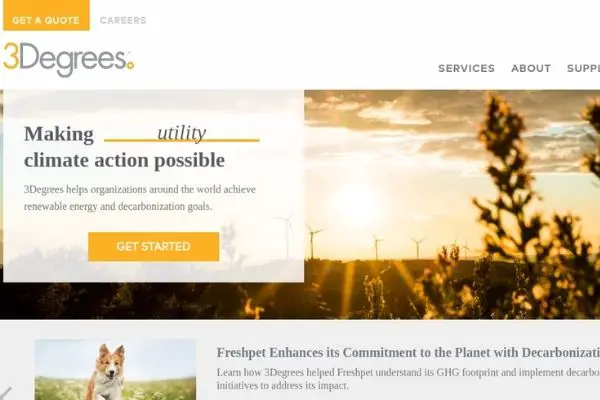
3Degrees has made a name for itself as a top organization that targets businesses whose main objective is to remove carbon from their operations.
Founded in 2007, 3Degrees is committed to the idea that industrial businesses have a major role to play in reducing the effects of carbon on the planet.
It has helped launch several voluntary projects in the US which include solar programs, renewable gas transactions, and trade options in Renewable Energy Certificate.
3Degrees mainly focuses on carbon reduction and removal projects. They also have high standards for environmental and social programs and are a Certified B Corporation.
Their program also aims at achieving optimal environment sustainability by offsetting emissions from an individual employee’s commuting and business travel as a whole!
What they offer:
3Degrees have a bunch of projects under their umbrella:
- Solar power
- Wind power
- Oil recycling
- Biogas projects
- Landfill methane gas capture/destruction
- Agricultural methane combustion/capture
- Energy efficiency
- Emission reduction
Accountability
3Degrees also shows great levels of transparency through helping out programs like Etsy to make their shipping greener.
They’re also recognized by:
- Gold Standard
- CAR (Climate Action Reserve)
- VCS (Verified Carbon Standard)
- American Carbon Registry (ACR)
Pros:
- Certified B Corporation
- Third-party verified projects
- Transparency
Cons:
- Does not cover individuals
3. Carbon Easy
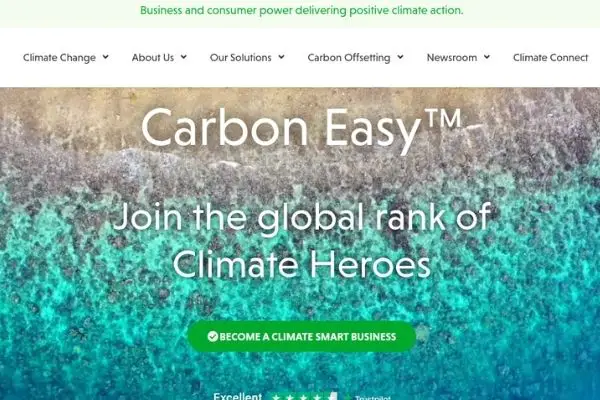
Carbon Easy by Paying.Green is a stellar non-profit offset program known for helping businesses reduce their carbon footprint while remaining cost-effective at the same time.
They have taken smart technology and fused it with eco-friendly innovations that help to realize sustainable living.
They have tons of diverse projects like Climate Connect™ that help bring value to businesses by attracting more clients while offering greener energy solutions in the same stroke.
Carbon Easy is undoubtedly one of the most convenient programs in the market with a seamless online subscription system. This model is mainly designed for small and medium-sized businesses that want to get involved in offsetting but don’t want the headache that comes with the technical details.
It’s basically touch-and-go!
The program also tries to use as much of the subscriber’s dollar as possible to get the greatest number of offsets from it. Unlike other organizations, they don’t rely on predetermined averages that are popularly used by other programs.
The best thing is that they can scale their offer based on the size of your business and you get a certification after successfully registering.
What they offer:
The most popular offset projects in the program include:
- Biogas energy
- Fossil fuel switch
- Afforestation and reforestation
- Waste handling & disposal
- Hydro energy
- Biomass
- Wind
- Nitrous oxide abatement
- Solar power
- Energy efficient-household utilities
Accountability
To confirm their transparency, Carbon Easy has in place a stringent carbon credit governance that works under the UNFCCC’s (United Nations Framework Convention of Climate Change) best practice principles.
They also retrain their staff on an ongoing basis based on new trends and research to ensure that they have current solutions to current problems.
That aside, they also have third-party recognition from:
- Gold Standard
- VCS
- Clean Development Mechanism (CDM)
Pros:
- Monthly, quarterly, and yearly subscriptions
- Carbon Offsetting Certificate
- Issues reports
- Transparent
- Third-party verified
Cons:
- Only receives donations through partner businesses
4. Terrapass
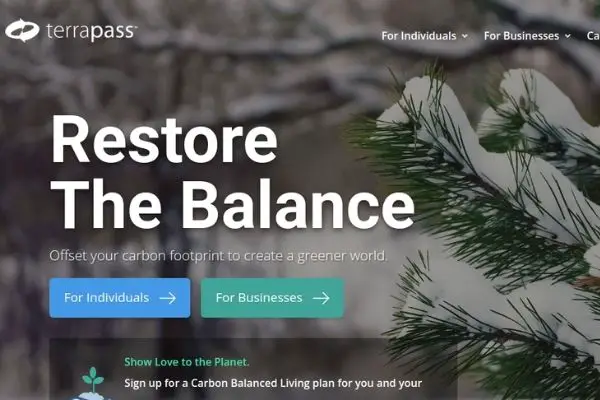
Terrapass is the most flexible program offering monthly subscriptions on this list. It gives an amazing one-month plan to businesses that want to help reduce carbon effects without committing too much.
Founded in 2004, Terrapass was first launched as JustEnergy’s subsidiary that helped individuals offset their carbon footprint released from driving and other household activities. As years progressed, they grew to serve small businesses and companies to also achieve the same goal.
Instead of only focusing on the business side of carbon offsetting, Terrapass makes a great effort to educate the masses on why climate change matters. It campaigns on how every individual or business’s efforts towards the issue go a long way in tackling the problem.
Their most popular product is the monthly offset packages. These are computed by totaling an employee’s expected emissions and multiplying them by the number of employees you have in your organization.
…Figures why most small businesses run to them without second thoughts!
What they offer:
Some of the main offset projects include:
- Wind power
- Landfill methane capture
- Organic waste management
- Farm power
- Methane capture from abandoned coal mines
Accountability
Aside from rigorous audits, Terrapass also receives third-party verification from:
- Gold Standard
- Climate Action Reserve
- Green-e Energy
- American Carbon Registry
- VCS
Pros:
- Caters to individuals as well
- Green-e Energy Certified
- Great monthly plans
Cons:
- Offers offsets to US-based businesses only
5. MyClimate
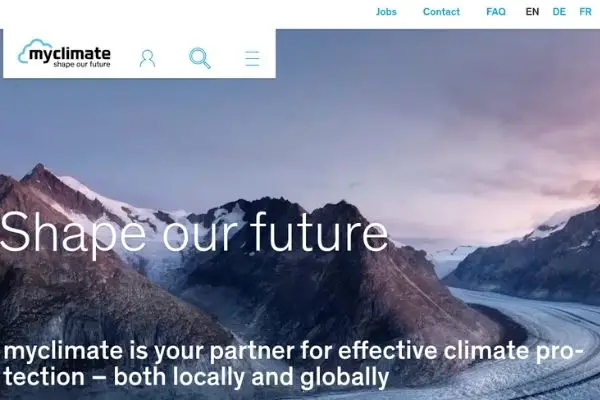
Founded in 2002, MyClimate still stands out as the most project-diverse carbon offset program to date. Its main headquarters is located in Zurich, Switzerland, and has overseen more than 120 projects in 37 different countries!
As a result, they’ve also ended up creating a lot of employment and job opportunities for thousands of people in the respective regions they operate in.
And like TerraPass, they also flourish in mass information and educational programs aiming at raising awareness on climate change. As of the moment, they have reached about 1,600 students and trainees globally and some 10,000 more in Switzerland. They have also taught more than 25,000 students in Switzerland too!
What’s more, MyClimate serves private individuals, businesses of all sizes, and non-profit organizations. Their goal is to ensure that your funds are actively used to fight carbon emissions for long-term success.
What they offer:
To give you just a tip of the iceberg, they deal in:
- Biogas
- Energy efficiency
- Hydropower
- Wind power
- Forestry
- Efficient cooking stoves
- Water treatment and conservation
- Biomass
- Solar energy
- Waste management
Accountability
MyClimate is also qualified by third-party standards like:
- Gold Standard
- CDM
- Plan Vivo
Pros:
- Simple calculators
- Third-party certified
- Educational programs
- Lots of ongoing projects
Cons:
- Rough website navigation
How We Picked the Programs
Carbon offsets are very sensitive and sniffing out joy-riders from genuine projects can be a real challenge. So, how did we qualify the programs reviewed in this article?
We used these 5 major factors to help us cut through the noise:
1. Environmental integrity
Will they deliver the promised carbon offset?
The purpose of carbon offsets, in great part, is to help reduce emissions while also finding effective solutions to the current levels.
Most of the programs listed above have proven, through records and reviews, that they have delivered on both promises.
2. Sustainable development goals

Are they constantly working to bring more environmentally sustainable projects to the world?
The Kyoto Protocol says that carbon offsets should ensure that sustainable, eco-friendly avenues have also been funded and fully exploited.
This is part of a goal that seeks to increase energy-efficient solutions to mitigate the current damage being done by the continuing CO2 emissions.
3. Approved by recognized standards
These standards are accredited by the UN to help as third-party oversights on the quality verification of the carbon offsets being sold.
They ensure that the emission versus cost values quoted by the programs is valid and correct.
Some of the top bodies dealing in this type of verification include Gold Standard, Clean Development Mechanism (CDM), Plan Vivo, Verified Carbon Standard (VCS), and Climate Action Reserve (CAR).
4. Carbon calculators
This is a small yet significant aspect that’s crucial to the overall experience and achievement you’ll get from acquiring carbon offsets.
Carbon calculators have to be simple and easy for businesses to use. This enables them to have clear accounting when recording transactions made from every offset purchase.
5. How big is their offset portfolio?
The more offset projects a program has in its portfolio, the more impact it’ll likely make in cutting greenhouse emissions and absorbing the current CO2.
Most of these offset programs handle way more than a handful of projects stemming from prevention to the elimination of these harmful gases.
How We Determined the Quality of Carbon Offsets
According to a report from the University of Pennsylvania, there are 4 main criteria used to qualify carbon offsets:
1. Additionality
It’s a buzz word in the world of carbon offsets, yet not many people understand what exactly it means. This factor should determine whether CO2 reduction will still happen even without buying the offset.
To put it clearly…
If a business buys carbon offsets but would have cut their carbon emission anyway using new efficient technology (or maybe because new regulation is forcing them), then the offsets bought won’t be ‘additional’.
2. Permanence
It refers to whether the carbon reduction or mitigation will carry through the stated period. This is mainly used when validating tree planting carbon offsets.
Every program has to ensure that the trees they planted will thrive for the full years quoted in the offsets’ purchase.
And it does make sense. If you plant trees today only to cut them down in 10 years, they won’t have lived long enough to soak up the amount of CO2 you pledged to get rid of!
3. Absence of leakage
This is used to ensure that the amount of carbon reduced or eliminated in one place does not crop up in another.
It may typically happen when a lumber company is prevented from cutting trees in one forest but then negotiates and is allowed to log trees in another area. Or another country where regulation is less strict!
Eventually, this will end up canceling the net carbon decrease instead.
4. Verification
This refers to whether a credible authority has made sure that all of the above criteria have been met.
Carbon Third-Party Standards
To quickly sum this up, carbon third-party standards are structures that have been put in place to verify the quality and quantification of purchased offsets.
Right now, there are several standards available from different verifiers, but I am only going to highlight 3 that are most commonly used.
1. Gold Standard
Gold Standard is a very strict third-party verifier that was found by several global organizations including the World Wildlife Fund (WWF).
It sets itself apart by insisting that these offset projects must also achieve certain sustainable development goals apart from curbing carbon emissions. Gold Standard requires that carbon offset projects should add value to the social and economic welfare of the respective communities where they’re being carried out.
Now, Gold Standard’s sustainability requirements are more stringent than both VCS’s and CDM’s. This has led them to work on a narrower set of projects that include waste management, renewable energy, energy efficiency, forestry, and land use.
2. Verified Carbon Standard (VCS)
Verified Carbon Standard was formed in part by the IETA (International Emissions Trading Association). IETA is a large group having members from leading chemical and energy companies, law firms, and major banks.
And unlike Gold Standard or CDM, VCS doesn’t require your sustainability projects to contribute to the social or economic benefits of the areas they’re carried out. Naturally, this has led to them having more projects than Gold Standard.
3. Clean Development Mechanism (CDM)
CDM was established by the UN as a standard under the Kyoto Protocol. It’s globally regarded as the baseline that the other existing standards are compared against.
In addition, it is a standard that only deals with projects based in developing countries. It hosts more projects than the Gold Standard but not quite as many as in VCS.
It also has more stringent sustainability requirements than VCS but is not as tough as Gold Standard.
Now, CDM has a blight in its reputation with many critics questioning the additionality of its projects in the said developing nations.
Benefits of Offsetting for Businesses
Carbon offsets for businesses, when done voluntarily and correctly, may come with various benefits – and NOT just environmental.
Some of them include:
- Improved credibility and reputation for businesses directly dealing with customers.
- Increased internal focus on your business’s environmental balance sheet.
- Increased knowledge in the voluntary carbon markets will come in handy when carbon-constrained economies finally settle in.
- Improved credibility and networking with industry-leading groups that may earn you a say in future policy-making.
- Innovative and conservative employees inspired to preserve the purity of the environment.
Offsets Pricing and Why it Varies
You first have to know that carbon offsets pricing is not universal – meaning that your business will get different quotations from different providers.
As of 2016, carbon offsets were selling at an average price of $3/ton while the price also ranged from $0.5/ton to more than $50/ton!
So, why this great variance?
The reasons are vast and skewed but I’ll attempt to explain the most glaring ones:
- Most of the carbon offsets are bought in bulk due to economies of scale or price discounts. This mainly leads to lower price points per purchase than those that are bought in lesser volumes.
- The variance might also be brought about by different profit or overhead margins set by the various providers.
- The types of projects offered also affect pricing. Providers that back effective and successful projects have a higher chance of getting higher prices on their products due to the good reputation that comes from it.
- Pricing is also affected by the total cost of verification and quantification. If a known standard is directly involved in the monitoring of the offsets, then the price tends to go higher.
- Carbon prices in voluntary markets are normally lower than in a compliance market. This is because such units have a lower demand compared to those sold in compliance markets.
- The location of the projects could also determine how high or low a business has to pay for carbon offsets. This is because different states and regions have diverging laws or rules that could either favor the buyer or cost him more dollars.
Frequently Asked Questions
Who can buy carbon offsets?
Right now, carbon offsets can be bought by virtually any entity that wishes to reduce the effects of its carbon footprint and support sustainable solutions. These include industrious, learning, and professional organizations.
This development has helped even small businesses to cheap in the fight against climate degradation.
How much do carbon offsets cost?
The cost of carbon offsets varies from $0.1 to $70+ per ton depending on a few factors.
This includes the project’s location, whether it’s third-party verified or not, and the amount of purchase intended.
What are some examples of carbon offsets?
The main offset projects include reforestation, developing renewable energy, harnessing wind and solar power, and exploiting biomass energy.
Other examples include energy-efficient household utilities, methane capture or conversation, and bio-sequestration.






